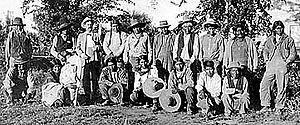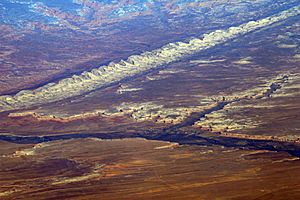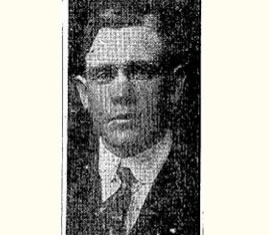Posey War facts for kids
Quick facts for kids Posey War |
|||||||
|---|---|---|---|---|---|---|---|
| Part of the Ute Wars, American Indian Wars | |||||||
 A group of Ute and Paiute Native Americans who were involved in the Posey War of 1923. Chief Posey is standing second from left. |
|||||||
|
|||||||
| Belligerents | |||||||
| Commanders and leaders | |||||||
| Posey † | |||||||
| Casualties and losses | |||||||
| none | 2 killed | ||||||
The Posey War was a short conflict involving Native Americans in Utah. It happened in March 1923. This event caused many Ute and Paiute people to leave their homes near Bluff, Utah. They went into the deserts around Navajo Mountain.
The Native Americans were led by a chief named Posey. He took his people into the mountains to escape those chasing them. Unlike earlier conflicts, local groups called posses played a big role. The United States Army was not very involved. The conflict ended after a small fight at Comb Ridge. Posey was badly hurt. His group was taken to a temporary camp in Blanding. After authorities confirmed Posey's death, the prisoners were set free. They were given land to farm and raise animals. Some historians say it was more of an "exodus" (a mass departure) than a war.
Contents
Why the Posey War Happened
The Posey War was the last in a series of conflicts between the United States and the Ute and Paiute tribes. For many years, the Ute people fought to keep their traditional lands in San Juan County. Most of these disagreements were settled through talks. But sometimes, there were small fights, like the Bluff War in 1915.
By 1923, Chief Posey and his group were well-known from earlier events. Posey was part Paiute and part Mexican. He married into the Ute Mountain tribe. His group had about 100 Ute and Paiute men, women, and children. They lived near Bluff, along Allen Canyon. They often worked for the settlers in town. Some Utes said Posey's group did not want to live on the reservation. They felt the people there were not friendly.
The Posey War started in February 1923 because of a small incident. Two young Ute boys from Posey's group caused trouble at a sheep ranch. They stole sheep, hurt the owner, killed a calf, and burned a bridge. The boys later gave themselves up to Sheriff William Oliver in Blanding. While in custody, they got sick. They were allowed to go home, promising to return for their trial.
Meanwhile, the ranch incident was used as a reason to gather all Native Americans living near Bluff. Some were captured and held in a fenced area in Blanding. But most left their lands and went into the wilderness. When the trial began on March 20, the boys returned to town. One of them, Joe Bishop's son, was using a stick to walk. Chief Posey and some of his men came to the trial. They wanted to help the boys and protect their land in San Juan County.
The Conflict Begins

The Blanding Incident
The first part of the trial finished without problems. But when court stopped for lunch, Sheriff Oliver took the two boys to eat. Sheriff George A. Hurst, who was there, wrote about what happened next. Joe Bishop's son seemed sick and was using a stick to walk. After the trial, the boy was found guilty. Sheriff Oliver was supposed to take him to lunch and bring him back for sentencing later.
When the sheriff tried to get the boy to go, the young Ute threw away his stick. He grabbed the reins of the sheriff's horse. He pulled hard. Sheriff Oliver tried to use his gun, but it did not fire. Joe Bishop's son then grabbed the gun from the sheriff's hand. He quickly jumped onto the horse of Jess Posey (Chief Posey's son) and rode off. As he rode away, he managed to get the gun to work. He shot the sheriff's horse in the neck.
After this, Chief Posey and his people fled. A group of local men, called a posse, chased them in a car. Posey fired his rifle, damaging the car. This stopped the chase for a while. Now Posey was wanted by the law. He went north with his group from Allen Canyon to the desert near Navajo Mountain. News reports began to spread, making exaggerated claims about Posey and his group. They were accused of various crimes.
The Fight at Comb Ridge
On March 22, a newspaper article claimed that the "Piute Band Declares War on Whites in Blanding." The article also said that local leaders had asked Utah Governor Charles Mabey for permission to use a military plane to attack the Native Americans. This request was not approved. The state offered a $100 reward for Posey, dead or alive.
A reporter named C. F. Sloane wrote very inaccurate stories from Blanding. He claimed Blanding was under "thirty-six hours of terrorism." He wrote that Utes in war paint were riding through the streets. He also said Posey was forming a "mobile squadron" to rob a bank. When a citizen asked a newsman why he wasn't writing the truth, the newsman replied, "We're not ready to go home yet." He meant they needed to keep the story exciting to stay.
Rumors spread that another Indian war was about to begin. So, the settlers in Blanding and Bluff quickly formed a larger posse to find Posey and his followers. They also tried to stop outside interference, which had caused problems in earlier conflicts. The posse followed Posey's group. The next day, they caught up with them about twenty miles from Blanding. This was in a rough desert area with many canyons.
The Native Americans fought a rearguard action from the top of Comb Ridge. This allowed their women and children time to escape. Eventually, everyone surrendered over the next few days. Posey escaped, but he was shot in the hip by a settler named Bill Young. The newspapers again made up their own versions of the story. One said Posey died in a flash flood. Another said he died of old age. Many Utes believed he died from poisoned flour. But it is generally thought that Posey died from a serious infection caused by the gunshot wound. During the fighting, which lasted until March 23, Posey was said to have shot and killed Joe Bishop's son. They reportedly argued on the ridge. Posey was angry that the boy had caused so much trouble. Other stories say the posse killed the Bishop boy.
What Happened Next
Seventy-nine Ute and Paiute prisoners were taken to Blanding and held in a compound. They were released a few days later when Posey's body was found in Comb Wash. Marshal Jesse Ray Ward was taken to the spot by a group of Utes. There, he officially identified the body and confirmed Chief Posey's death.
The last of the Ute Wars was over. After Posey's group was released from Blanding, they returned to the Allen Canyon area. They received 160-acre plots of land. Chief Polk's group, who were part of the 1915 Bluff War, also received 160-acre plots near Montezuma Canyon. The Native Americans agreed to stop their nomadic way of life. They would start farming and allow their children to attend Indian schools.
It was slow for Posey's group to adjust to this new life. Throughout the 1920s, they continued to live in tents or traditional hogans (earthen huts). Other Utes were already living in houses. In 1930, an official said that the Native Americans of Allen Canyon were "at least 40 years behind the Southern Utes" in their progress. Chief Posey and the son of Joe Bishop were the only two people who died during the conflict. There were no deaths on the American side. However, the Native Americans did kill one of the posse's horses and nearly hit several men.


